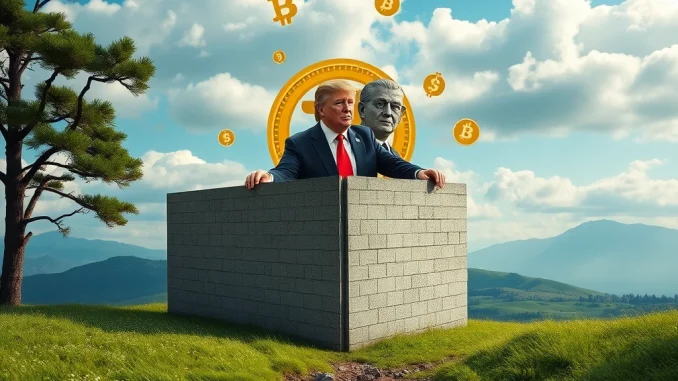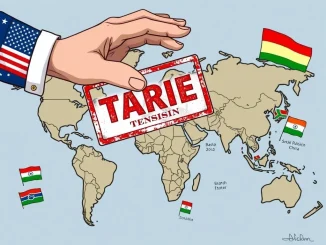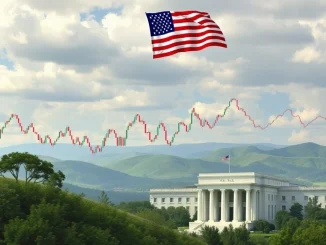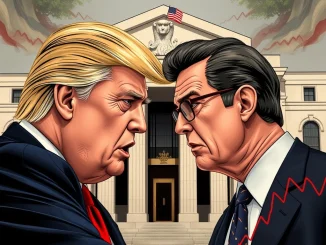
Even in the fast-paced world of cryptocurrency, where innovation and decentralization often steal the spotlight, understanding the undercurrents of traditional finance is crucial. Why? Because macroeconomics, heavily influenced by institutions like the Federal Reserve, can significantly sway investor sentiment and capital flows, ultimately impacting digital asset markets, including Bitcoin.
Donald Trump’s Striking Criticism of Jerome Powell
In a moment that captured headlines, former U.S. President Donald Trump delivered sharp remarks regarding the Chairman of the Federal Reserve, Jerome Powell. During a press conference at the White House, Trump characterized communication with Powell on monetary policy matters as akin to “talking to a wall.” This vivid analogy underscored his deep frustration with the Fed’s approach, particularly its reluctance at the time to lower benchmark Interest Rates.
Trump’s critique wasn’t just about communication style; it was fundamentally about the direction of U.S. Monetary Policy. He highlighted a perceived disconnect between the Fed’s stance and that of other major central banks globally. Specifically, he pointed to actions taken by institutions like the European Central Bank (ECB) and the People’s Bank of China, both of which were actively pursuing policies to lower their respective benchmark rates.
The core of Trump’s complaint against Jerome Powell was centered on speed and responsiveness. He felt that the Fed was too slow to adjust its policy in response to economic conditions or, perhaps more pointedly, in alignment with his administration’s economic goals. This public pressure on the independent central bank raised questions about the balance between political influence and the Fed’s mandate for stable prices and maximum employment.
Why Did Trump Want Lower Interest Rates?
From a political and economic perspective, lower Interest Rates are often viewed favorably by administrations seeking to stimulate economic growth. Here are some common arguments for rate cuts:
- **Encouraging Borrowing:** Lower rates make it cheaper for businesses and consumers to borrow money, potentially leading to increased investment and spending.
- **Boosting Exports:** A side effect can be a weaker domestic currency, making exports more competitive on the global market.
- **Stimulating Inflation:** In periods of low inflation, rate cuts can help push inflation towards the central bank’s target.
- **Stock Market Support:** Lower rates can make stocks more attractive relative to bonds, potentially boosting equity markets.
Donald Trump frequently emphasized economic growth and market performance as key metrics of his presidency. His push for lower rates aligned with a desire to further accelerate the economy and potentially counter any perceived headwinds.
How Does the Federal Reserve Set Monetary Policy?
The Federal Reserve operates under a dual mandate from Congress: to achieve maximum employment and stable prices (low inflation). Its primary tool for influencing the economy is Monetary Policy, primarily through setting the target range for the federal funds rate, the interest rate at which banks lend to each other overnight. Here’s a simplified look:
- **Federal Open Market Committee (FOMC):** This committee is the principal body for setting U.S. monetary policy. It meets regularly to assess economic conditions.
- **Economic Data Review:** The FOMC analyzes a wide range of data, including employment figures, inflation rates, GDP growth, and consumer spending.
- **Setting the Federal Funds Rate:** Based on their assessment, the FOMC votes on whether to raise, lower, or maintain the target range for the federal funds rate.
- **Influencing Other Rates:** Changes in the federal funds rate influence other interest rates throughout the economy, including those for mortgages, car loans, and business credit.
The Fed’s decisions are meant to be independent of political pressure, allowing them to make choices based solely on economic data and their mandated goals, even if those decisions are unpopular with the executive branch.
The Global Contrast: ECB and PBoC Actions
Trump’s comparison highlighted a divergence in global Monetary Policy approaches at the time. While the Federal Reserve was holding steady or raising rates, the European Central Bank (ECB) and the People’s Bank of China (PBoC) were moving towards easing. This contrast is important:
| Central Bank | Action Noted by Trump | Potential Reasoning |
|---|---|---|
| Federal Reserve (US) | Holding/Raising Rates | Focus on domestic inflation control, strong employment |
| European Central Bank (Eurozone) | Lowering Rates | Stimulating sluggish economic growth, combating low inflation |
| People’s Bank of China (China) | Lowering Rates | Supporting economic targets, managing specific sector risks |
This global divergence means that capital can flow towards regions offering higher returns (potentially where rates are higher) or towards regions where policy easing is expected to boost asset prices. This dynamic directly impacts international finance and trade.
How Does Fed Policy Impact Cryptocurrency?
Here’s where the connection to our world becomes clear. Decisions made by the Federal Reserve on Interest Rates and overall Monetary Policy have ripple effects that reach the crypto market:
- **Risk-On vs. Risk-Off Sentiment:** Lower interest rates generally encourage a “risk-on” environment, making investors more willing to allocate capital to potentially higher-yielding, but riskier, assets like technology stocks and cryptocurrencies. Higher rates tend to favor a “risk-off” stance, pushing investors towards safer assets like bonds.
- **Liquidity:** When the Fed eases monetary policy (e.g., quantitative easing), it injects liquidity into the financial system. Some of this liquidity can find its way into alternative assets like Bitcoin. Tightening policy removes liquidity.
- **Inflation Hedges:** While debated, some view Bitcoin as a potential hedge against inflation caused by expansive monetary policy. Trump’s pressure for lower rates (potentially inflationary) could, in theory, bolster this narrative.
- **Dollar Strength:** Fed policy affects the strength of the U.S. dollar. A stronger dollar can sometimes correlate with weaker commodity and risk asset prices, while a weaker dollar can have the opposite effect.
Therefore, Trump’s public pressure on Jerome Powell and the Fed’s subsequent policy decisions are not isolated events for crypto investors. They are significant macroeconomic signals that can influence market trends and investor behavior.
Challenges and Implications of Political Pressure
The public tension between Donald Trump and Jerome Powell highlighted the delicate position of the Federal Reserve. The challenge lies in maintaining independence while navigating intense political scrutiny. Implications include:
- **Uncertainty:** Political pressure can create uncertainty about the future path of Monetary Policy, making it harder for businesses and investors to plan.
- **Credibility:** Repeated public attacks can potentially erode the public’s confidence in the central bank’s independence and credibility, which is crucial for the effectiveness of monetary policy.
- **Market Volatility:** Any perceived conflict or unexpected policy shift driven by non-economic factors can lead to increased volatility in financial markets, including traditional assets and potentially cryptocurrencies.
Understanding this dynamic is key for anyone trying to make sense of broader market movements.
What Can Crypto Enthusiasts Learn?
While the crypto world champions decentralization, it doesn’t exist in a vacuum. Here’s an actionable insight:
Pay attention to macroeconomic indicators and central bank commentary, especially from the Federal Reserve. Decisions on Interest Rates and the overall approach to Monetary Policy by Jerome Powell and the FOMC can provide valuable context for understanding potential shifts in market sentiment and liquidity that may affect your crypto holdings. Don’t just follow crypto news; follow the money flows influenced by global economic policy.
Summary: The Wall, The Rates, and The Ripple Effect
Donald Trump’s memorable “talking to a wall” comment about Jerome Powell wasn’t just political theater; it was a public expression of frustration over the direction of Federal Reserve Interest Rates and Monetary Policy. This pressure, contrasting with the easing policies seen at the ECB and PBoC, underscores the complex global economic landscape.
For those in the cryptocurrency space, these events serve as a critical reminder that even decentralized assets are influenced by the gravitational pull of traditional finance and macroeconomic forces. Understanding the decisions made by powerful institutions like the Federal Reserve provides essential context for navigating the broader financial markets and anticipating potential impacts on the crypto ecosystem.



